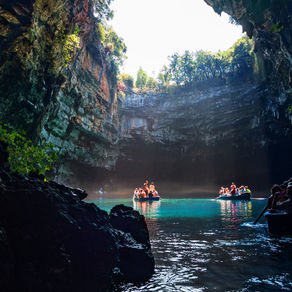Pontikonisi Islet | Corfu | The Mythical Secrets of the Stone Ship of Legends
- Shiny Greece
- Jun 8, 2019
- 3 min read
Updated: Mar 25, 2025
Authors
George - The Shiny Greece Team (feat. ai)
Pontikonisi Islet is a picturesque island located in the Ionian Sea, just off the coast of Corfu. It is a small, rocky islet with a dense green vegetation and a white-washed church sitting atop a hill. The islet has a rich history and mythology that dates back to ancient times, making it a popular tourist destination. There is also a famous Greek song for Pontikonisi which has been sang by one of the most successful Greek actresses of the old cinema, Rena Vlachopoulou. In this article, we explore the history, culture, and significance of Pontikonisi Islet, and discover what makes it such a unique and beloved attraction.

Pontikonisi Island | Photo by: Dreamsdestroyer, Pontikonisi Island, CC BY-SA 4.0
The Myth of Pontikonisi
According to Greek mythology, Pontikonisi Islet was once a ship that was turned to stone by the god of the sea, Poseidon. Legend has it that the ship belonged to Odysseus, the protagonist of Homer's epic poem, the Odyssey. It is said that Odysseus' ship was returning from the Trojan War when it was turned to stone by Poseidon, as a punishment for the disrespect shown to the god. Today, the islet is known as "Mouse Island", named after the Greek word "pontikos" which means "mouse" due to its small size and shape resembling a mouse.
The History
Aside from its mythology, Pontikonisi Islet has a long and rich history that dates back to the Byzantine era. The island served as a strategic location for the Byzantine fleet and was used as a lookout point for invading ships. Later, during the Venetian rule of Corfu, Pontikonisi Islet was fortified with defensive structures, including a tower and a gun battery, to protect the island from Ottoman attacks. In the 17th century, the island was used as a quarantine station for ships arriving from the east, as a measure to prevent the spread of diseases.

Pontikonisi Islet Corfu | Photo by: iStock.com, hannurama
The Church of Pantokrator
At the top of the hill on Pontikonisi Islet sits the white-washed church of Pantokrator, which was built in the 11th century. The church is dedicated to the "All Mighty" and is one of the oldest churches in Greece. The church has undergone several renovations over the centuries, but its original structure and design remain intact. The interior of the church is adorned with beautiful frescoes and icons, depicting scenes from the Bible and the lives of the saints. The church is a popular destination for tourists and locals alike, who come to admire its beauty and history.
The Natural Beauty of the Islet
Aside from its historical and cultural significance, Pontikonisi Islet is also renowned for its natural beauty. The islet is surrounded by crystal clear waters, which are perfect for swimming and snorkeling. The islet's rocky terrain is covered with lush green vegetation, including olive trees, cypresses, and myrtles. The islet is also home to a variety of wildlife, including rabbits, hares, and a rare species of lizard called the "skyros wall lizard". Visitors to the islet can enjoy a leisurely stroll along its scenic walking paths, which offer breathtaking views of the surrounding sea and landscape.

Metamorfosi tou Sotiros Church at Pontikonisi Island | Photo by: Kritzolina, Byzantinische Kapelle auf Pontikonisi, Korfu 05, cropped by Shiny Greece, CC BY-SA 4.0
A Beloved Spot
Pontikonisi Islet is a unique and fascinating destination, steeped in history, culture, and mythology. Its picturesque scenery, ancient church, and crystal-clear waters make it a beloved spot for visitors and locals alike. Whether you come to explore its rich history, admire its natural beauty, or simply relax and soak up the sun, Pontikonisi Islet is a must-see destination for anyone visiting Corfu.
































































It's myth is great!
You can only reach it by boat from the pier of Vlaherna.